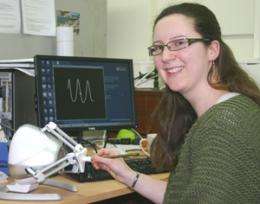Student’s idea gives graphic details to visually impaired scientists

Whether it's a bar chart showing the debt of European countries, or a graph indicating the rise of carbon dioxide in the atmosphere, graphics are a powerful communications tool that many of us take for granted.
But how do you describe the ‘hockey stick' effect, so influential in climate science, or show how ageing populations cause demographic ‘bulges', to someone who can't see a printed chart?
An undergraduate student at the University of Reading has come up with an answer - use innovative technology that allows visually impaired or blind people to feel and hear a virtual graph.
Ruth White, a final year student in the School of Systems Engineering at the University of Reading, is developing new ways to help visually impaired students to perceive a graph in real time through the senses of touch and sound.
Earlier this month she was selected as a finalist of SET for Britain, and was asked to present her research findings at a House of Commons event, aimed at raising the profile of promising early-career scientists among MPs and further afield.
Ruth's work aims to help visually impaired students use a low-cost haptics system - a computer-controlled robot-like device which responded to movement and touch - to feel the shape of data presented graphically.
"People in science and engineering subjects often need to visualise large amounts of data, but for those who are visually impaired it would be meaningless to hear a screen reader read out an almost endless list of numbers," she said.
"It is important to develop techniques such as this in order to provide visually impaired students with greater access to education and careers in scientific subjects."
Ruth, 24, who is in the final year of a Masters degree in Cybernetics, first developed the system with help from the Nuffield Foundation, which funded an undergraduate summer research placement. She is currently working to improve the system as part of her final year research project, with feedback from potential users.
Professor William Harwin, Professor of Interactive Systems, said: "Ruth has developed an excellent idea, using simple but well-designed technology to make a real difference to the lives of fellow students, and I congratulate her on being asked to present her idea at Westminster.
"The code she has used is open-source, so engineers and designers will be able to use and build on her work for free, making it genuinely useful in the future."
Provided by University of Reading



















